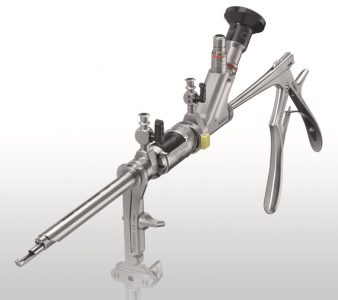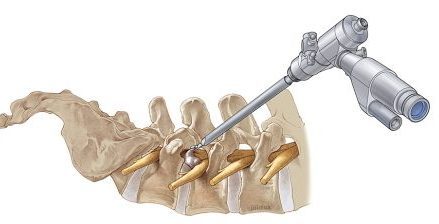Endoscopic Spine Surgery
Endoscopic Spine Surgery in Mumbai
Endoscopic spine surgery involves use of an endoscope to visualize the disc and inside of the spinal canal. Endoscope provides a magnified and well illuminated view on a big TV screen. Long, narrow instruments are passed through the endoscope to perform required surgery inside. Endoscopic discectomy is most commonly done procedure; however, endoscopic spinal stenosis decompression and endoscopic spine fusion surgeries are also done. Many of these surgeries can be done under local anesthesia and as day care procedure. Endoscopic spine surgeries provide all benefits of minimally invasive spine surgery.
Types of Endoscopic Spine Surgeries:
- Endoscopic Discectomy: Lumbar disc herniation is most common indication of endoscopic spine surgery. Endoscopic discectomy involves removing only the herniated part of the disc. It can be done as 1) Trans-foraminal endoscopic discectomy or 2) Interlaminar endoscopic discectomy, depending upon location of herniated disc and surgeon’s preference.
- Endoscopic Spine Decompression: Lumbar spinal stenosis can be decompressed using a wider endoscope and removing tissue causing pressure on spinal cord (ligamentum flavum, overgrown fact joints, herniated disc).
- Endoscopic Lumbar Fusion: A complete endoscopic discectomy is performed. Bone graft and cage are inserted in intervertebral space using a small tube under fluoroscopy guidance. Percutaneous pedicle screws are then inserted using small holes in skin.
- Posterior Cervical Endoscopic Discectomy: A smaller endoscope is used to remove herniated part of cervical disc from posterior micro-foraminotomy approach. This avoids anterior complete discectomy which then requires a fusion procedure. Only laterally herniated discs are treatable by endoscopic micro-foraminotomy.
- Endoscopic Disc Debridement: Infective discitis caused by bacteria or tuberculosis can be debrided with the help of spine endoscope. This reduces pain and also provide tissue for further testing.
Various other procedures like anterior cervical discectomy and procedures on thoracic spine can also be performed with the help of spine endoscope. Endoscope can be used to visualize front part of spinal cord to confirm adequate anterior decompression by posterior approach.
Advantages of Endoscopic Spine Surgery:
- These are most minimally invasive spine surgeries with all the advantages of an MIS spine surgery.
- Many procedures can be done under local anesthesia hence suitable for older patients with medical problems.
- These are very safe procedures due to magnification and illumination provided by endoscope.
Disadvantages/ Limitations of Endoscopic spine Surgery:
- Specialized training is required.
- Specialized OT setup and equipment are required.
- Surgeries are slightly costlier due to use of specialized instruments.
- Sometimes, an adequate decompression is not achieved by endoscopic procedure.
- Not all pathologies are treatable by endoscopic techniques.


Cost of endoscopic spine surgery can be slightly higher than regular spine surgeries. Various specialized endoscopic spine equipments are used during endoscopic spine surgery. In addition, certain disposable instruments are required afresh for every patient. These both factors increases the cost of endoscopic spine surgery.
However, patient’s hospital stay is reduced after endoscopic spine surgery and this in turn, reduces the cost. Also, patients are able to get back to their daily routine faster. So, overall cost burden eventually proves cost-effective to the patient.
Endoscopic spine surgery is a very safe procedure. As surgeon is able to see spinal structures in a magnified and well illuminated environment with the help of endoscope, chance of damaging any spinal structure is very minimal.
A minimally invasive spine surgery is essentially a spine surgery done with minimum collateral damage to surrounding soft tissues and muscles. Endoscopic spine surgery requires insertion of a very small diameter endoscope to perform spine surgery, and hence is most minimally invasive spine surgery.
Though not all cases are treatable by endoscopic spine surgery, for carefully selected cases, endoscopic spine surgery has a very high success rate. Endoscopic discectomy and endoscopic spinal stenosis decompression are now established techniques with excellent results.

Total cost for MIS for lumber stenosis L3/L4 and L4/L5
Please send your MRI films on draks777@gmail.com. After looking at them I can give a quote.